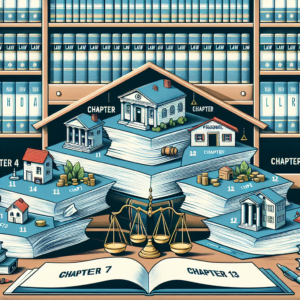
In recent months, bankruptcy courts across the nation have delivered a series of rulings that have sent shockwaves through the financial community. These decisions not only reshape the landscape of bankruptcy law but also expose the complexities and often hidden truths of the judicial process. This article delves into the role of bankruptcy courts, the factors influencing recent rulings, their impact on stakeholders, the importance of transparency, notable case studies, and the future implications for the bankruptcy system.
Understanding Bankruptcy Court: An Overview of Its Role and Function in Financial Disputes
Bankruptcy courts serve as specialized judicial bodies designed to address the financial disputes of individuals and businesses unable to meet their debt obligations. Their primary function is to provide a legal framework for the fair and orderly resolution of debts, ensuring that creditors are treated equitably while allowing debtors a chance to reorganize or liquidate their assets. The court’s role extends beyond mere adjudication; it involves overseeing the bankruptcy process, approving repayment plans, and facilitating negotiations between debtors and creditors. By doing so, bankruptcy courts aim to restore financial stability and promote economic recovery for affected parties.
Key Factors Leading to Shocking Bankruptcy Court Rulings: Analyzing Recent Trends and Patterns
Recent trends in bankruptcy court rulings reveal a confluence of factors that have contributed to unexpected outcomes. Economic volatility, exacerbated by the COVID-19 pandemic, has led to an increase in filings, prompting courts to navigate unprecedented challenges. Additionally, the rise of digital assets and the complexities surrounding them have introduced new legal considerations. Courts are increasingly confronted with cases involving cryptocurrency, e-commerce, and the gig economy, which complicate traditional bankruptcy frameworks. Furthermore, shifts in consumer behavior and regulatory changes have influenced judicial interpretations, resulting in rulings that often defy established precedents.
The Impact of Bankruptcy Court Decisions on Creditors and Debtors: A Closer Examination
The ramifications of bankruptcy court decisions extend far beyond the immediate parties involved. For creditors, rulings can significantly alter recovery prospects, often leading to reduced payouts or extended timelines for debt collection. Debtors, on the other hand, may find themselves navigating a labyrinth of legal obligations and restrictions that can hinder their financial rehabilitation. The balance of power in bankruptcy proceedings is delicate; recent rulings have highlighted the need for creditors to adapt their strategies while also emphasizing the importance of providing debtors with a fair opportunity to restructure their financial affairs. The outcomes of these decisions can have lasting effects on credit markets and the broader economy.
Unveiling Hidden Truths: The Role of Transparency in Bankruptcy Court Proceedings
Transparency in bankruptcy court proceedings is crucial for maintaining public trust and ensuring accountability within the judicial system. However, recent rulings have raised concerns about the opacity of certain processes, particularly regarding the treatment of confidential information and the influence of powerful stakeholders. Critics argue that a lack of transparency can lead to inequitable outcomes, as creditors with more resources may exert undue influence over proceedings. To address these concerns, advocates for reform are calling for clearer guidelines and enhanced disclosure requirements, aiming to create a more equitable environment for all parties involved in bankruptcy cases.
Case Studies: Noteworthy Bankruptcy Court Rulings That Changed Legal Precedents
Several high-profile bankruptcy court rulings have emerged as pivotal moments in shaping legal precedents. One such case involved a major retail chain that sought to restructure its debts while simultaneously attempting to reject unfavorable leases. The court’s decision to allow the rejection set a new standard for how bankruptcy courts interpret lease agreements, influencing similar cases across the industry. Another landmark ruling involved a technology company that faced insolvency due to litigation costs. The court’s innovative approach to asset valuation and creditor treatment not only provided a lifeline for the debtor but also established a framework for future cases involving intellectual property disputes. These case studies illustrate the evolving nature of bankruptcy law and its capacity to adapt to contemporary challenges.
Future Implications: What Recent Rulings Mean for the Bankruptcy System and Stakeholders
The recent wave of bankruptcy court rulings signals a transformative period for the bankruptcy system and its stakeholders. As courts grapple with the complexities of modern financial disputes, the implications of these decisions will likely reverberate throughout the legal landscape. Stakeholders, including creditors, debtors, and policymakers, must remain vigilant and adaptable in response to these changes. The evolving nature of bankruptcy law may necessitate new legislative measures to address emerging issues, such as the treatment of digital assets and the rights of gig economy workers. Ultimately, the future of the bankruptcy system will depend on its ability to balance the interests of all parties while promoting fairness and transparency.
As the bankruptcy landscape continues to evolve, the recent shocking court rulings serve as a reminder of the intricate interplay between law, finance, and societal norms. By understanding the underlying factors that drive these decisions and advocating for greater transparency, stakeholders can better navigate the complexities of bankruptcy proceedings. The ongoing dialogue surrounding these issues will be crucial in shaping a more equitable and effective bankruptcy system for the future.




















